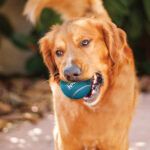
Labrador Retrievers are known for their friendly nature, intelligence, and beautiful coats. However, maintaining that sleek and shiny coat requires regular grooming. Whether you’re a new Labrador owner or a seasoned dog lover, these tips will help you keep your furry friend’s coat and overall health in top condition.
Regular Brushing Reduces Shedding
Labradors are notorious shedders, which can be a challenge for any pet owner. To manage this effectively, brush your Labrador’s coat at least once a week. Frequent brushing helps remove loose hair, reduces shedding, and prevents matting. Use tools like a grooming glove or a slicker brush to reach the undercoat, which is where most of the shedding hair resides.
Tools You’ll Need:
- Grooming Glove: Ideal for a quick brush while petting your dog.
- Slicker Brush: Efficient in reaching the undercoat and removing loose hair.
Bathe Sparingly to Maintain Natural Oils
While it might be tempting to bathe your Labrador frequently, doing so can strip their skin of natural oils, leading to dryness and irritation. Aim to bathe your Labrador every 2-3 months using a mild dog shampoo. This frequency keeps their coat clean without compromising their skin’s health.
Bathing Tips:
- Use Mild Shampoo: Choose a shampoo specifically formulated for dogs.
- Rinse Thoroughly: Ensure all shampoo is rinsed out to prevent skin irritation.
- Dry Properly: Towel dry and use a blow dryer on a low setting if necessary.
Ear Care to Prevent Infections
Labradors are prone to ear infections due to their floppy ears, which can trap moisture and debris. Regularly check and clean their ears to prevent infections. Use a vet-recommended ear cleaner and a cotton ball to gently clean the outer part of the ear. Avoid inserting anything deep into the ear canal to prevent damage.
Signs of Ear Infections:
- Foul odor
- Redness or swelling
- Excessive scratching or shaking of the head
Nail Trimming for Comfort and Health
Overgrown nails can cause discomfort and even affect your Labrador’s gait. Trim your Labrador’s nails every 1-2 months to avoid these issues. If you’re unsure how to trim their nails, ask your vet or a professional groomer for guidance.
Tips for Nail Trimming:
- Use Proper Tools: Invest in a good quality nail clipper designed for dogs.
- Trim Gradually: Take off small amounts at a time to avoid cutting the quick.
- Reward Your Dog: Make the experience positive with treats and praise.
Dental Hygiene to Prevent Gum Disease
Dental care is often overlooked but is crucial for your Labrador’s health. Brushing their teeth daily or at least three times a week can prevent dental problems such as gum disease and tooth decay. Use a dog-specific toothbrush and toothpaste to make the process easier and more effective.
Dental Care Tips:
- Start Early: Introduce brushing to your dog as a puppy to get them accustomed.
- Use Dog-Specific Products: Human toothpaste can be harmful to dogs.
- Check for Signs of Dental Issues: Bad breath, swollen gums, and difficulty eating are red flags.
Paw Care to Keep Pads Healthy
Your Labrador’s paw pads take a lot of wear and tear. Regularly check and clean their paw pads to keep them healthy. Look for cuts, cracks, or foreign objects lodged between their toes. Use a damp cloth to wipe their paws after walks, especially if they’ve been on rough terrain.
Paw Care Tips:
- Inspect Regularly: Make it a habit to check their paws after outdoor activities.
- Moisturize: Use a vet-approved paw balm if you notice dryness or cracking.
- Trim Fur Around Paws: This prevents mats and keeps the area clean.
Common Grooming Issues Specific to Labradors
Shedding
Shedding is a significant issue for Labradors, requiring regular and thorough grooming to manage. Consistent brushing and using the right tools are essential to keep shedding under control.
Ear Infections
Due to their floppy ears, Labradors are prone to ear infections, necessitating frequent cleaning and inspection. Regular ear care routines can prevent these painful infections.
Overgrown Nails
Overgrown nails can cause discomfort and affect your Labrador’s gait, making regular trimming essential. Neglecting nail care can lead to more severe health issues down the line.
Dental Problems
Without proper dental care, Labradors can suffer from gum disease and tooth decay. Establishing a routine dental care regimen is crucial for their long-term health.
Matting
Their thick and water-resistant coat can become matted if not properly cared for. Regular brushing and occasional baths can keep their coat in pristine condition.
FAQs
How often should I brush my Labrador’s coat?
Brush your Labrador’s coat at least once a week. During shedding seasons, you may need to brush more frequently
What type of shampoo should I use for bathing my Labrador?
Use a mild dog shampoo specifically formulated for pets. Avoid using human shampoos as they can strip natural oils from your dog’s skin.
How do I clean my Labrador’s ears?
Use a vet-recommended ear cleaner and a cotton ball to gently clean the outer ear. Avoid inserting anything deep into the ear canal.
How can I make nail trimming less stressful for my Labrador?
Use high-quality nail clippers and trim gradually. Reward your dog with treats and praise to make the experience positive.
What are the signs of dental problems in Labradors?
Signs include bad breath, swollen gums, and difficulty eating. Regular brushing and dental check-ups can prevent these issues.








